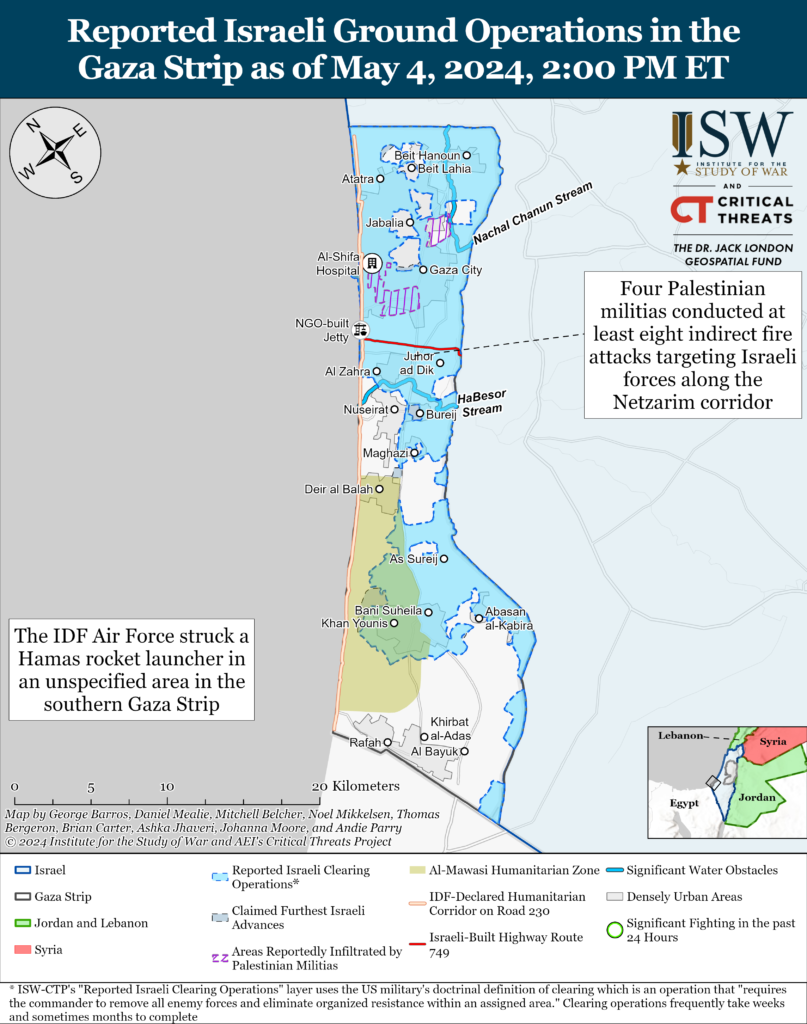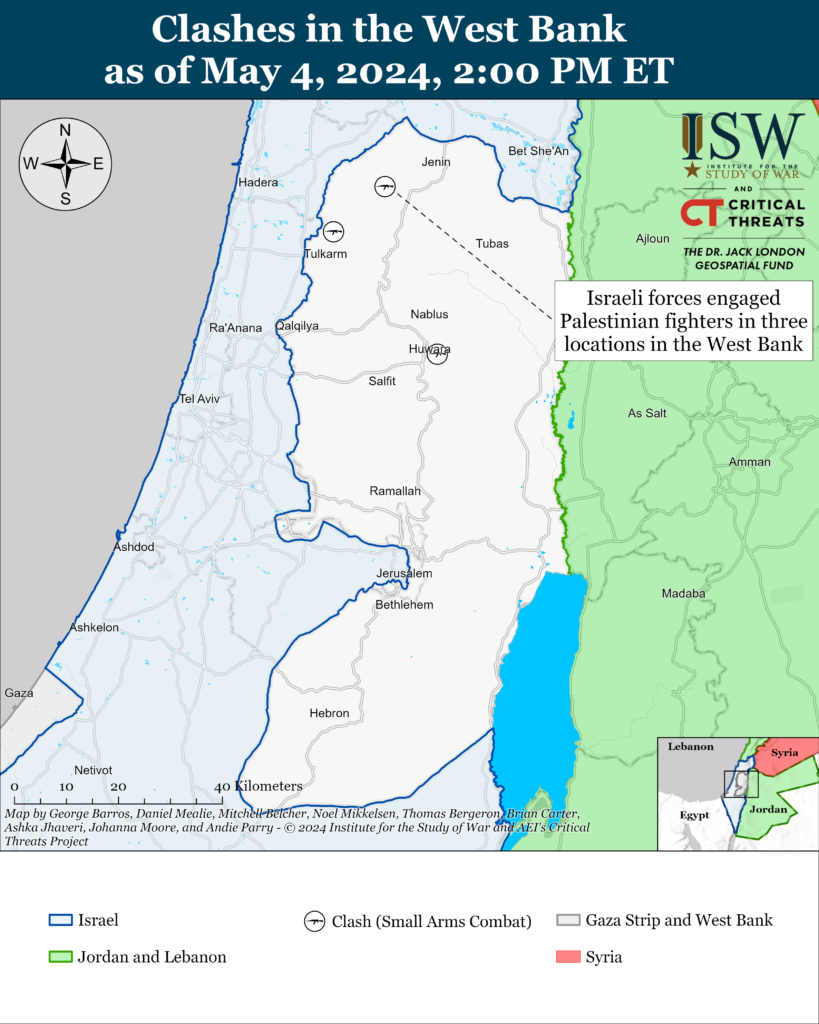Hamas and Qatari delegations arrived in Cairo to discuss the current ceasefire proposal on May 4.[i] Hamas is expected to present an official response to the proposal during the discussions.[ii] Arab mediators told the Wall Street Journal that the head of Hamas in the Gaza Strip, Yahya Sinwar, said on May 3 that the proposed deal is the closest deal to Hamas’ demands so far, but Sinwar raised several conditions.[iii] Hamas Political Bureau member Ghazi Hamad said that the group is still considering the proposal and considering its response.[iv] Senior Hamas official Mahmoud Mardawi told Palestinian media on May 3 that Hamas is skeptical that Israel will implement the ceasefire deal given internal Israeli politics.[v] Israel has not sent a delegation to participate in the talks, but an unnamed Israeli official said that Israel will send a delegation to Cairo if there is “positive movement” on the Hamas side regarding a deal.[vi]
Key Takeaways:
- Gaza Strip: Four Palestinian militias conducted at least eight indirect fire attacks targeting Israeli forces along the Netzarim corridor on May 3 and 4.
- Ceasefire Negotiations: Hamas is expected to present an official response to the proposal during the current ceasefire talks. A senior Hamas official said that Hamas is skeptical Israel will implement the ceasefire given internal Israeli politics.
- West Bank: Israeli forces have engaged Palestinian fighters in at least three locations in the West Bank since CTP-ISW’s last data cutoff on May 3.
- Lebanon: Iranian-backed fighters, including Lebanese Hezbollah, have conducted at least five attacks from southern Lebanon into northern Israel since CTP-ISW’s last data cutoff on May 3.

Gaza Strip
Axis of Resistance objectives:
Erode the will of the Israeli political establishment and public to sustain clearing operations in the Gaza Strip
Reestablish Hamas as the governing authority in the Gaza Strip
Four Palestinian militias conducted at least eight indirect fire attacks targeting Israeli forces along the Netzarim corridor on May 3 and 4.[vii] Israeli forces have established forward positions along the Netzarim corridor to facilitate future raids into the northern Gaza Strip.[viii] Palestinian militias have claimed almost daily attacks targeting Israeli forces near the Netzarim corridor since April 18.[ix]
The Israel Defense Forces (IDF) struck Palestinian militia infrastructure in the central Gaza Strip on May 4. The IDF Air Force, in coordination with the 215th Artillery Brigade (162nd Division) conducted airstrikes targeting mortar launchers in an unspecified area in the central Gaza Strip.[x] The IDF Navy struck unspecified targets in the central Gaza Strip to support the IDF 99th Division there.[xi]
The IDF Air Force struck Palestinian militia infrastructure and other unspecified targets in the southern Gaza Strip on May 4. The IDF Air Force conducted airstrikes targeting a Hamas rocket launcher in an unspecified area in the southern Gaza Strip.[xii] The IDF Air Force struck unspecified targets near a launch site in Khan Younis.[xiii] The IDF said that it conducted the strikes after it identified an unspecified launch from the area towards Ein Hashlosha, which fell in an open area.[xiv]


Unspecified Palestinian fighters conducted an indirect fire attack targeting Ein HaShlosha.[xv]

Recorded reports of attacks; CTP-ISW cannot independently verify impact.
West Bank
Axis of Resistance objectives:
Establish the West Bank as a viable front against Israel
Israeli forces have engaged Palestinian fighters in at least three locations in the West Bank since CTP-ISW’s last data cutoff on May 3.[xvi] Israeli security forces conducted an overnight raid in Deir al Ghusoun targeting a militia cell barricaded in a building.[xvii] Israeli forces fired on the building and demolished it.[xviii] Local footage showed Israeli forces raiding the building and the arrest of at least one individual.[xix] The al Aqsa Martyrs’ Brigade targeted Israeli forces with “machine guns“ and improvised explosive devices (IED) during the raid.[xx] The IDF killed five Palestinian fighters.[xxi]

This map is not an exhaustive depiction of clashes and demonstrations in the West Bank.
Southern Lebanon and Golan Heights
Axis of Resistance objectives:
Deter Israel from conducting a ground operation into Lebanon
Prepare for an expanded and protracted conflict with Israel in the near term
Expel the United States from Syria
Iranian-backed fighters, including Lebanese Hezbollah, have conducted at least five attacks from southern Lebanon into northern Israel since CTP-ISW’s last data cutoff on May 3.[xxii]

Recorded reports of attacks; CTP-ISW cannot independently verify impact.
Iran and Axis of Resistance
Nothing Significant to Report.
 Eurasia Press & News
Eurasia Press & News


